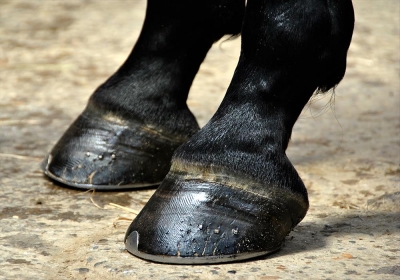
|
Ungulates are animals whose toenails have evolved into hooves. The number of toes they can be either odd or even. Cattle, deer and hippopotamuses are all even-toed. Horse belong to the odd-toed group, as do rhinoceroses. |
The ungulates arose from early mammalian stock at the start of the Cenozoic era some 60 million years ago and by the Eocene, some 20 million years later, they had become large, heavy-bodied herbivores many of which were destined to be replaced, in the Miocene, by fleet-footed grazers. Even in the early days of the ungulates three distinct groups began to emerge. Thus although the cow group (even-toed) and the horse group (odd-toed) may seem linked they have a long history of separate evolution.
Of the two, the even-toed species have proved to be the better survivors for almost all the medium to large plant-eaters in the world belong to this group. The more primitive even-toed species include pigs and the peccaries (found in South America), which have four well-developed toes on each limb. They are omnivorous in their choice of food and their dentition is less specialized than in many other forms. Hippopotamuses, which retreat to water during the daytime, come ashore to feed at night, and in some areas of Africa are major crop thieves. Camels, which are highly adapted for desert life, have only two toes on each foot, as do their South American relatives the closely similar llama, guanaco, and alpaca. All of these animals have some upper teeth.
The upper front teeth of the other even-toed, cud-chewing ungulates are missing and are replaced by a horny pad, but they can take in food tremendously fast, often using the tongue to tear at vegetation. The food is passed to a holding compartment in the stomach and regurgitated later to be masticated thoroughly before being swallowed a second time, after which digestion proper starts. One advantage of chewing the cud is that food which may have been gathered in dangerous areas and rapidly eaten can be digested later in a place of comparative safety. Deer, giraffes, antelopes, cattle, sheep, and goats all chew the cud.
Odd toed-animals were at one time more numerous than at present; today only horses, rhinoceroses, and tapirs survive. The rarity of the first two is largely due to persecution by man, and the true wild horses and asses and the three species of Asiatic rhinoceroses are among the rarest mammals in the world, although the zebra is relatively common in parts of Africa. No odd-toed animal chews the cud, and none has any true horns, those of the rhinoceros being made of compressed hair. The rhinos have three toes on each foot, the tapirs have four on the front feet and three on the hind feet, while horses (including donkeys and zebras) have lost all but the large central toes of each foot. The balance of the leg is therefore completely different from that of the even-toed animals.
A group of animals found in Africa and the Near East and thought to be closely related to the elephants is that of the hyraxes, small, dumpy yet agile creatures which live socially in forested or rocky areas. All have hoof-like nails on the four toes of the front feet and a large claw on the innermost of the three toes of the hind feet.
Credit : David darling
Picture Credit : Google




